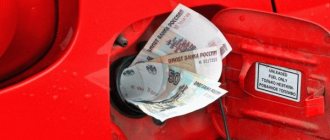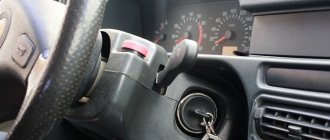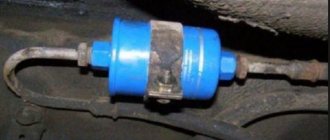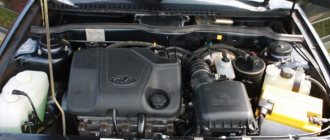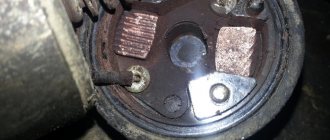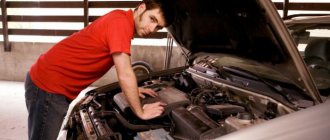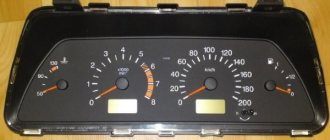Chevrolet - Niva, the elusive module.
I got a call, my Chevy Niva car won't start. On site, the owner explains that at first it sometimes crashed spontaneously, after a while it started up and could work normally for a few days to a few weeks. Then the cases became more frequent, and as a result, while parked, the engine flatly refused to start.
I'm trying to connect diagnostic equipment, but there is no connection with the engine control unit. Together with the owner, we decided to tow the car to a service station. In the end, I decide to try to restart, and lo and behold, the engine starts with half a turn, as if nothing had happened. Okay, let's go together. On the floor - it froze again on the way, we had to be towed. On the way, I’m already wondering what it could be: alarm, wiring, power, crankshaft sensor? And almost before the gate everything ended just as unexpectedly. So I went to the workshop alone.
First I reconnect with the control panel. Due to the disabled immobilizer, diagnostic line K hung in the air. I install the jumper, there is a connection! The Bosch MP 7.0 control unit has not registered any error codes in its memory. I turn on the engine, the parameters are ok, it works fine. So they usually check the power source, masses, time, fuel pressure, and take oscillograms. Everything is fine, there are no deviations. This always happens. I'm taking a wait-and-see approach; sooner or later a technical problem will show itself. What I didn’t do, warmed up, cooled down, drove at high speeds and idling, started and stopped, knocked on the wheel, but the engine worked properly, not wanting to reveal its secret.
And finally, in the evening, after 6 hours of almost continuous monitoring, the engine stopped starting. I quickly look at the parameters on the scanner - there are no errors or deviations. There is fuel pressure, a signal is sent to the injectors, but there is no spark. There is a hint. The signal from the crankshaft sensor goes to the ECU, there is power and ground on the ignition module, does this mean that the module itself remains? I think it's impossible for both module channels to fail at the same time. I connect an oscilloscope, there is control from the unit, which means the module itself is faulty! I put the new one in and the engine ran fine.
Here is such a mysterious module, I want it to work, but I want it not to work. Because its design doesn't fold, it keeps its secret in a trash can
It happens that the starter works normally, but the engine stubbornly refuses to start, although the Check light is not on. In such cases, if we talk about the VAZ-2123 engine, we can immediately name 10 different reasons. All of them will be quite real and not at all from the category of “oxidized contacts”. In general, sometimes the Chevrolet Niva does not start, but the starter turns the shaft regularly and there is no need to look for the reason. Well, let's try to learn to recognize different reasons, that is, to distinguish one from the other.
Example in the video: the APS immobilizer blocked the engine because it was in learning mode!
Why the Chevrolet Niva does not start: the starter turns, but the engine does not catch
It happens that the starter works fine, but the engine stubbornly refuses to start, although the Check lamp does not light up. In such cases, if we talk about the VAZ-2123 engine, we can immediately name 10 different reasons. All of them will be quite real, and not at all from the category of “contacts have oxidized.” In general, sometimes the Chevrolet Niva does not start, but the starter turns the shaft properly, and the reason should not be looked for there. Well, let's try to learn to recognize different reasons, that is, to distinguish one from the other.
Example in the video: the APS immobilizer blocked the engine because it was in learning mode!
14.5. It won’t start - useful tips
| GENERAL INFORMATION |
Your technical equipment must be impeccable - after all, the time you have is the same money that, we hope, you also have.
Don't lose either one or the other. If a missing tie out of nowhere or a pant leg burnt by an iron can cause a business meeting to be disrupted, what can we say about a car that doesn’t want to start an hour before the scheduled negotiations. . Early in the morning, freshly shaved and full of great plans (child – to school, wife – to the hairdresser, and yourself – to forge a penny), you jump into the car, “key to start” and. What the hell. One more time. More. Nervous manipulations with the key and pedals do not bring success. The day is ruined from the very beginning. Plans and mood are down the drain.
Calm down. There is no need to rush under the hood in an English suit and, smearing the oily dirt with a tie, try to make a diagnosis. You probably won't be able to cure it in 5 minutes. Take another car, and leave the treatment of your sick friend until the evening. And it’s better to entrust it to doctors with a good reputation, especially if you have an expensive car and you are not a specialist. It will be cheaper this way. Well, if your friend is well known to you and you consider yourself a healer, well, try it yourself, if you’re not too lazy to get dirty or there’s no other way out.
The diagnosis must be made calmly
Mentally examine the symptoms. First, does the starter turn? And if so, how cheerful? You already know the answer - remember what happened the first time you tried to start the car. If you don't remember, try again.
If the starter does not turn at all and does not even click the traction relay when the ignition is turned on, then it is either faulty (you can close the hood and follow the advice given above: “Take another car.”), or there is a problem with the battery - it has turned off or died. Only in rare models can the starter power circuit be protected by a fuse - about 300 amperes - it is not difficult to find, especially if you know in advance where it is located. If the battery is to blame, then, as a rule, all electrical equipment does not work. The simplest and easiest case is that one of the terminals has come off or is dirty, but the battery is fine. Tighten the terminals on it and on the starter (if equipped). If it turns out that the battery is completely dead (forgot to turn off the headlights at night), you can still leave. But with outside help. Here, as they say, options are possible. You can try to start from a push, from a hill or from a tow. Don’t try to get around the pitfalls: a car with an automatic transmission or electronic fuel injection (if it has an electric fuel pump) will not be able to start using these methods. I'll have to light a cigarette at my neighbor's. However, for some machines this can lead to damage to the computer (read the instructions for the machine). If the starter turns on, but is sluggish (this happens in the summer, in winter this is a subject for a separate discussion), most likely the battery is almost completely discharged. This will be visible by weak headlights or weak signal. In this case, the above options for outside assistance come into play.
If the starter turns briskly, but the engine does not respond to attempts to start it, feel free to exclude everything related to the battery from further considerations. Blame the ignition or fuel supply system, you can’t go wrong. When diagnosing and treating each of them, a systematic approach is required. It’s better to start with the ignition - problems occur there more often. Especially in wet weather.
From a spark it will ignite.
So, we need to look for a spark. Your car may be equipped with a classic (simple) contact ignition system, a rather complex electronic contactless one, or some combination. In any case, the system consists of three parts. Part one is low-voltage (breaker contacts in a classic system or a special sensor in an electronic one, plus a box with electronic filling that forms a spark). Part two is a step-up transformer, called an ignition coil in the world. Part three is high voltage (mechanical or electronic distributor and wires through which high voltage current is supplied to the spark plugs). And of course, the candles themselves. The inspection of this entire enterprise must be carried out in stages and it is better to start from the end.
Stage one
. High voltage part of the system. Check to see if there is a spark on the center wire - this is the one that connects the coil to the distributor. The tip of the wire must be removed from the distributor cap, brought closer to any part that has good contact with the body of the car (it doesn’t matter whether it is painted or not), and secured so that there is a gap of 5–7 mm between the tip and the selected part.
If your car has an electronic ignition, the wire must be fastened especially securely - if it falls on ground, the electronics will instantly die. For the same reason, you should not scratch the wire across the body. We also do not recommend holding it with your hand, not even with your own - it will give you a serious electric shock.
Stage two.
Crank the engine with the starter. At the same time, watch what happens at the tip of the wire. There are two options. More favorable - there is a spark. Powerful, accompanied by a loud click. This significantly narrows the field of further searches.
The first step is to remove the distributor cap. It may be damp and dirty underneath. Along such a “conductor” the spark readily jumps anywhere, just not where it needs to be. Wipe, clean and dry. At the same time, it is not harmful to clean the distributor contacts, for example, with fine sandpaper. Inspect the so-called “runner”. If you find a dark trace of electrical breakdown on it or on the distributor cap, the part will have to be replaced.
Carefully check the wires going from the distributor to the spark plugs. Wires and their tips must be dry and clean. If, in your opinion, everything is in order with them, you can put the cover back in place, restore the connections and try to start the engine. If the malfunction was hidden under the cover, the engine will start or, in the worst case, at least start sneezing. The symptom is also favorable - you are on the right track. True, you will have to turn out, clean and dry the spark plugs - in an attempt to start the engine, you filled them with gasoline. If the engine does not even sneeze, the spark plugs will still have to be turned out, cleaned and checked. It's easier if you have a spare set.
Chevrolet Niva does not start: three different sensors
The crankshaft position sensor will not indicate its failure in any way. The Check light will not light up, the engine will simply not start. Finding this sensor is easy if you know where the alternator belt is (see photo).
DPKV sensor connector
Here we check the serviceability of the wiring, as well as the distance from the sensor to the “teeth” (0.8-1.2 mm).
The second suspicious element will be the temperature sensor. The engine may not start only if it breaks. In this case, the electric fan should work without turning off. That is, a break in the DTOZH sensor circuit is easily recognized.
Element “6” is DTOZH
In the photo there is a sensor, and to get to it, the air duct is removed.
If the idle speed control malfunctions, the engine on a Chevrolet Niva does not start, but the starter turns. By the way, the Check lamp may be on. Diagnostics:
- Just lightly press the gas and turn on the starter;
- If the engine starts, but without gas it does not start, it means the IAC is faulty.
Set of "electrical" reasons
The first step in diagnostics: remove the cap from any spark plug, install spark plug A17DVRM and, holding it with pliers, turn on the starter.
How to remove the cap
The spark plug must be held by the hexagon, the pliers must have insulated handles, and the spark plug body must touch the “ground”. As a result, a spark can be observed. If there is no spark, it means:
- The ECM is faulty or is not receiving voltage;
- The ignition coil module burned out;
- High voltage wires are faulty.
The drawing for point “1” is given below.
Power supply point to the ECM
The presence of a spark “in the air” does not guarantee its presence in the engine. The spark plugs may be faulty, the gap may be incorrect, etc.
The number of reasons why the Chevrolet Niva does not start, but the starter turns, has increased to 7.
Immobilizer blocks engine starting
If the immobilizer has been activated, then sooner or later it will block the engine from starting. It happens like this: when you turn on the ignition, the indicator flashes for 15 seconds, then goes out. And then the system produces sound signals.
“2” – immobilizer lamp
The APS-4 module can be disabled. For this you need a “red” training key. Well, the APS-6 unit cannot be turned off. Usually you have to flash the ECM.
There is no need to panic right away: perhaps the blocking occurs due to irregularities in the “reader” wiring.
Electrical problems
Poor starting may be caused by a malfunction in the electrical part of the vehicle. Most often, this is a discharged or failed battery. Also often the reason that it does not can be a malfunction of the starter. This happens due to it getting wet or reaching the end of its service life.
Oxidized battery terminals can cause poor engine starting. Therefore, they must be protected from oxidation by special means. And if this happens, then clean it.
No less often this occurs due to faulty spark plugs. They may suffer from bad gasoline, after which their normal operation will be disrupted. They may also simply reach the end of their service life.
Fuel rail
On the ramp next to regulator 5 there is a control fitting 3. It is closed with a cap, which is unscrewed and then carefully pressed on the spool.
If fuel flows, it means it is entering the ramp. But perhaps the necessary pressure is not created. Reasons: clogged filter cylinder, pump malfunction, etc.
The pressure should be 350 kPa (3.5 bar). It is controlled by unscrewing the spool and installing a pressure gauge. Before checking, you need to reduce the pressure!
If fuel does not flow, notice whether the pump turns on when the key is turned to the “I” mark. When the ignition is turned on “cold”, the pump should run for 10 seconds.
Additional mounting block
Know that fuse F2 and relay P4 are responsible for turning on the pump. There is also a main relay P5, and all these elements are located in a block mounted on the same bracket with the ECM (see photo).
Even if the pressure is normal, the injectors may be clogged. In addition, their wiring may be damaged.
Case from practice
What happens if water gets into gasoline? In the summer - nothing. And in winter, the power supply system can become clogged with ice. All elements are at risk, from the pump to the injector valves!
Electrical faults
There are quite a lot of components of electrical equipment for a Chevrolet Niva car. Sometimes, in order to find the cause of a breakdown, you have to check all the components one by one. However, the experience of car enthusiasts allows us to identify the most vulnerable elements that cause the malfunction.
- The battery is low. It may fail due to long service life.
- Starter malfunction.
- Lack of contact at the battery terminals.
- Lack of spark (malfunction of spark plugs, power wires, ignition module).
- Fuse blown.
- Ignition switch malfunction.
- Errors in the immobilizer operation.
Battery Niva Chevrolet
Due to insufficient battery charge, the starter does not rotate, the flywheel does not spin, and the combustible mixture in the combustion chamber does not ignite. To check the battery charge level, you need to use a multimeter.
Based on the results obtained, make a decision on the advisability of further use of the battery. The average battery life is 5 – 6 years, after which it needs to be replaced with a new one.
Lately it has become popular to buy gel batteries. Instead of the usual electrolyte, the compartments are filled with gel. The service life of batteries of this class is 25% longer than analogues.
Fuel system malfunctions
Even if fuel is supplied, but its pressure is not high enough, this may be the reason why the Chevrolet Niva does not start. Taking this fact into account, we will highlight the main malfunctions characteristic of cars with injection injection.
- Fuel pump malfunction.
- Fuel filter clogged.
- Clogged injectors.
Let us remind you that the most probable causes of failure are listed. It may be necessary to carry out further and more detailed diagnostics using special equipment. But if there is an opportunity to fix the problem yourself, the desire to take advantage of it is quite understandable. In addition, it is not that expensive financially.
Video diagnosing the causes of an uncertain cold start
The Chevrolet Niva will not start, we are looking for and eliminating the reasons.
There is no spark at the injector! Solution
Chevrolet Niva ignition coil
There is no spark on the injection engine. We are looking for a motive without a scanner.
FOUND. Chevrolet Niva
NIVA 65 thousand rubles for six months. No spark is the reason. Replacing the drive shaft oil seal. Buy NIVA
Won't it start?! Where to dig?! Look for “living” water for the “dead” Niva!
The situation on the road, the spark went out.
In the absence of a SPARK / DPKV crankshaft position sensor, check / major / major repairs on the VAZ 2115!
There is no spark at the spark plugs.
Troubleshooting electrical equipment
Battery
The battery rarely discharges suddenly. Often starting becomes difficult due to low starter speed. But there are also cases when the battery dies in a very short time. When you turn the ignition key, the dashboard may “come to life”, but when you try to turn on the starter, all the lights go out. This is an indicator of battery discharge. As a last resort, you can turn on the headlights and judge the condition of the battery by the brightness of the lamps. The way out is to charge the battery or replace it.
Starter
If the battery is in order, and clicks are heard when you turn the key, then they indicate a fault with the starter. If nothing happens (no reaction), then before sinning on the starter, you need to check the reliability of the connection of the supply wire to the starter solenoid relay. If the starter has become unusable, then its repair is possible, but it depends on the reasons, of which there may be several.
Causes of sparking problems
If there is no spark on the injector, and not, for example, on a carburetor or gear motor, you will have to try to identify the reasons for its loss. This is due to the fact that there are slightly more factors influencing spark formation in injection systems and they look more multifaceted. If we summarize the general list of possible causes of the problem, then it is worth highlighting the following most common ones:
- The spark plug or spark plugs are flooded with fuel - there is either no spark or very weak, the spark plugs themselves are wet;
- The spark plug or spark plugs are faulty - there is no spark at all, deposits on the contacts are usually black or white;
- The crankshaft sensor, ignition module, ignition coil, switch or distributor is faulty - there is no spark at all, the engine shows no signs of “life”, the injector does not work correctly;
- High-voltage wires have broken through or there has been a loss of contacts - one or two spark plugs do not work, the rest are fully operational;
- The injector electronics (ECU or wires) are faulty - the unit does not work correctly, there is no spark at all spark plugs;
- The injector nozzles are clogged - there is no spark at the spark plugs of specific cylinders, the injector is not working correctly.
Please note that for a complete and most accurate diagnosis, it is necessary to carry out several procedures at once:
- Naturally, check for a spark;
- Assess for the presence of the symptoms described above;
- Check for relevant errors on the dashboard or on-board computer screen;
- Check the potentially faulty unit (disassembly, cleaning, diagnostics with a multimeter, etc.).
If, based on the results of all diagnostic procedures, the problem is not identified, then, most likely, a visit to the service station cannot be avoided. Otherwise, it is quite acceptable to carry out repairs yourself, of course, if you have the proper skills, abilities and tools.
Troubleshooting the fuel system
First of all, you should make sure that the fuel pump is working. When you turn on the ignition, a humming sound should be heard from under the rear seat for a while (within a few seconds). It would be a good idea to measure the pressure in the fuel rail. A special fitting is provided for this. Low pressure may be due to a malfunction of the regulator located in the pump block. Usually this block is changed entirely.
The fuel filter is changed according to regulations. It should be replaced at the first suspicion. Even if it turns out not to be the problem, you still need to change the filter.
With injectors the situation is more complicated. They are checked at a special stand. But injectors often cause difficult starting, and they can become clogged all at once. Typically, if an injector is faulty, the check engine light will come on. Faulty injectors must be replaced.
To summarize, if the Chevrolet Niva does not start, it is worth conducting initial diagnostics yourself. Perhaps this will help avoid high service costs.
Source: chevniva.ru
Tips for care and maintenance of Niva Chevrolet
- Observe technical inspection intervals every 20,000 km;
- Buy original parts with factory catalog numbers. Avoid buying cheap analogues of dubious origin;
- During the warranty period from the manufacturer, visit a service station to undergo routine diagnostics with a note in the service book;
- Remember that the length of its service life depends on the driving style of the car;
- Observe the timing of the transition to the summer/winter tire seasons, check the tire pressure.
Electrical reasons
First of all, you need to remove the cap from the spark plug (any one) and install spark plug A17 DVRM. Holding it with pliers, turn on the starter.
To remove the cap, hold the spark plug by the hexagon (pliers with insulated handles are suitable). It is necessary that the spark plug body touches the “ground”. As a result, you will be able to see a spark. In the case where there is no spark, this indicates:
- malfunction of the ECM or lack of voltage;
- combustion of the ignition coil module;
- damage to high-voltage wires.
Checking for spark
Let's say your fuel-injected car has stopped responding to the ignition key and refuses to start. It is quite irrational to immediately complain about a malfunction in the ignition system. First of all, you need to make sure that it is the spark that has disappeared and not something else that has broken. To check spark plugs for the presence of the coveted “light”, you can resort to several procedures at once. Perhaps the most effective and simple ones are the following:
- The first method is a mass test. To implement it, you need to turn off the ignition, unscrew each spark plug in turn and, placing its body against ground (the metal body of the engine), try to start the engine;
- The second method is checking with a multimeter or a tester based on a piezoelectric element. This diagnostic option is quite similar to the method described above, except that the spark plug is applied not to ground, but to the contacts of the tester or multimeter. However, in this case there is no need to “turn” the starter; the spark must come from the devices themselves.
If, as a result of the above-mentioned testing methods, sparking on the spark plug is not detected, or there is a spark, but weak (dimmed, dim, dull), it is necessary to identify the cause of the malfunction. Do not forget that operating a car with a poorly functioning ignition negatively affects engine performance and significantly reduces its service life.
Note! Checking the spark on the injector is an extremely important undertaking, since such cars have very sensitive electronics. Considering this particular feature, it is important to carry out diagnostics carefully and as quickly as possible, that is, without numerous repetitions of the test and using only high-quality testers.
The immobilizer blocks engine operation
When the immobilizer is activated, one way or another, it will block the engine from starting. This happens when, with the ignition on, the indicator starts flashing for 15 seconds and then goes out. Next, the system sends sound signals.
It’s time to disable the module on the Chevrolet Niva APS-4. Here you will need a training key (red), but APS-6 cannot be turned off. Basically, the ECM is forced to flash. There is no need to panic: the blocking is probably due to a broken reader in the cable.
A little about the fuel rail
There is a control fitting 3 on the ramp with regulator 5. The latter is hidden by a cap; you need to unscrew it and carefully press the spool. Fuel poured out - therefore, it entered the ramp. However, it is possible that the required pressure is not generated. The reasons may be clogged filter cylinder, damage to the pump, etc.
The pressure must show 350 kPa, that is, 3.5 bar. To control it, unscrew the spool and then install a pressure gauge. On the eve of the test, you should reduce your blood pressure. If there is no fuel supply, you need to pay attention to whether the pump turns on or not when turning the key to the “I” mark. When cold, the pump should operate for 10 seconds with the engine running.
Note: What happens when there is water in gasoline? In the summer - nothing. But in winter, the food system sometimes becomes clogged with ice.
Fuel supply filter
There is always a small amount of moisture in the fuel. When this amount is increased, this is what can happen:
- the first start always goes without problems;
- After leaving the car in the parking lot, after 2-3 hours the driver will no longer be able to start the engine without repairs.
Everything mentioned should be attributed to the injection internal combustion engine. And here the fuel filter will be a candidate for failure. So, in the Chevrolet Niva it is located under the bottom in aluminum form. By the way, this is thought out on many machines.
VAZ 2114 no spark injector. repair
Quick transition Section for forum newcomers, novice diagnosticians and car owners Where to start? I am newbie! How can I start communicating, how can I ask questions? Where is my topic? Why was I banned? School of automotive diagnostics of Alexey Pakhomov. Fuel consumption. All about chip tuning and car diagnostics. Where can you get high-quality chiptuning (chip tuning). Chip tuning of domestic cars. Chip tuning of foreign cars.
Custom calibration of any ECM of foreign cars. Theoretical questions on internal combustion engines, diagnostics and chip tuning. Diagnostics and repair of domestic cars. Diagnostics and repair of foreign cars. Problems solved, cars made. Diagnostic practice. Exchange of experience Help section on a paid basis (Odo, SRS, etc.). Immobilizers, anti-theft protection. DC emulators (Emulators of a working catalyst).
Programs, equipment, tools and devices Programs, programmers, scanners, adapters, etc. Circuits, devices, adapters, equipment. Free software created by forum visitors. Spare parts and components for vehicle repair and maintenance. Aggregate tuning, boosting, sports technologies. SMS-Soft equipment for professional diagnostics and chip tuning. Trash (topics that violate the rules, are incorrectly formatted, etc.)
Pumping up excess air
As you know, a Chevrolet engine sometimes does not want to spin because too much air is drawn into the intake manifold. Therefore, it is worth checking the fixation of all pipes and more.
The cause of excess air is damaged VUT. The engine on a Chevrolet Niva does not start while the starter is turning, which means you need to look for the problem in the brake system. But you can do it simpler:
- remove the vacuum supply hose (from the amplifier side);
- close the hose gap with your finger by performing a test run;
- the engine starts, which means the problem has been found.
Despite its apparent simplicity, damage to the air supply is difficult to see. It is worth checking how the hoses are seated on the fittings and making sure the clamps are tight.
What to do if there is no spark at the injector? Possible problems
One of the most common reasons causing the inability to start a gasoline engine is the banal lack of spark at the spark plugs. Under such circumstances, there is nothing to ignite the combustible mixture on the compression stroke, and as a result, the engine refuses to work. Depending on what kind of power system the car is equipped with, it is determined exactly how to proceed to determine the exact cause of the lack of a spark and measures to return it. We’ll talk in more detail about this problem on injection engines today. Interesting? Then be sure to read the material below to the end.
Damage to the starting system
Failure may manifest itself in improper operation of the starter device. Let us highlight 5 main malfunctions of this mechanism:
- The starter does not turn. The reason lies in a violation of the contact units, a break or short circuit in the starter circuit, or damage to the traction relay.
- When starting the starter on a Chevrolet Niva, there are repeated clicks. This indicates a malfunction of the traction relay, which is held by the winding, a discharge of the battery, or loose contact connections in the starter circuit.
- The starter starts, but the armature either does not rotate or rotates slowly. The cause may be a discharged battery, broken contact connections, burnt contacts of the traction relay, worn brushes, dirty commutator, interturn/short circuit of the windings.
- The starter turns on, the armature rotates, but the flywheel does not move. The problem may be loosening of the starter to the clutch housing, breakage of the flywheel teeth or drive gear. This would also include slipping of the freewheel of the drive and damage to the lever.
- The starter does not turn off after starting the Chevrolet Niva engine. The reason is a malfunction of the freewheel of the starter device, sintering of the contacts of the traction relay. If this damage occurs, stop the engine immediately.
The above reasons require the intervention of specialists at a service station or upon arrival at an equipped garage. You can only check in advance with a voltmeter how discharged the battery is, and also pay attention to the tightness of the contact connections in the starter circuit.
Source: ladaprofi.ru
Bringing the car back to life
As for why a spark disappears, everything is probably very clear. Now, it would not be amiss to consider the order of her return. The reality is that in most cases, getting the spark back is a simple matter and just involves carefully checking the broken car. To be more precise, to normalize sparking it is required:
- Firstly, check the spark on the injector using the method described above, make sure that it has disappeared, and, at least indirectly, try to determine the cause of the malfunction;
- Next, it is enough to assess the current circumstances and act based on them. As typical situations, we suggest considering solutions to the following problems:
- the spark plug is wet, the presence and strength of the spark are unimportant, the carbon deposits are correct (brick color) - wipe the part and screw it back in;
- the spark plug is wet (not always) and the carbon deposits are incorrect (white or black) - clean, dry the part and try to start the engine, if there is no result, change the spark plug and deal with problems in the fuel system (cleaning the injector, checking the ECU, etc.);
- the spark plug is wet, there is no spark at all, the color of the soot is not important - we try to change the part, if there is no result, we check the ignition system and the operation of the injector.
In principle, in theory there are no particular difficulties in repairs of this kind. Despite this, it often causes difficulties in implementation for inexperienced motorists. To solve these, you need to act in the order described above, but if something doesn’t work out, it’s better to turn to professionals at a service station. This approach to repairs will not only save time, but also guarantee trouble-free operation of the car in the future.

